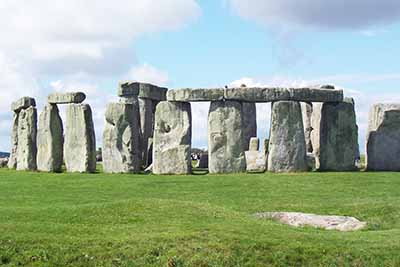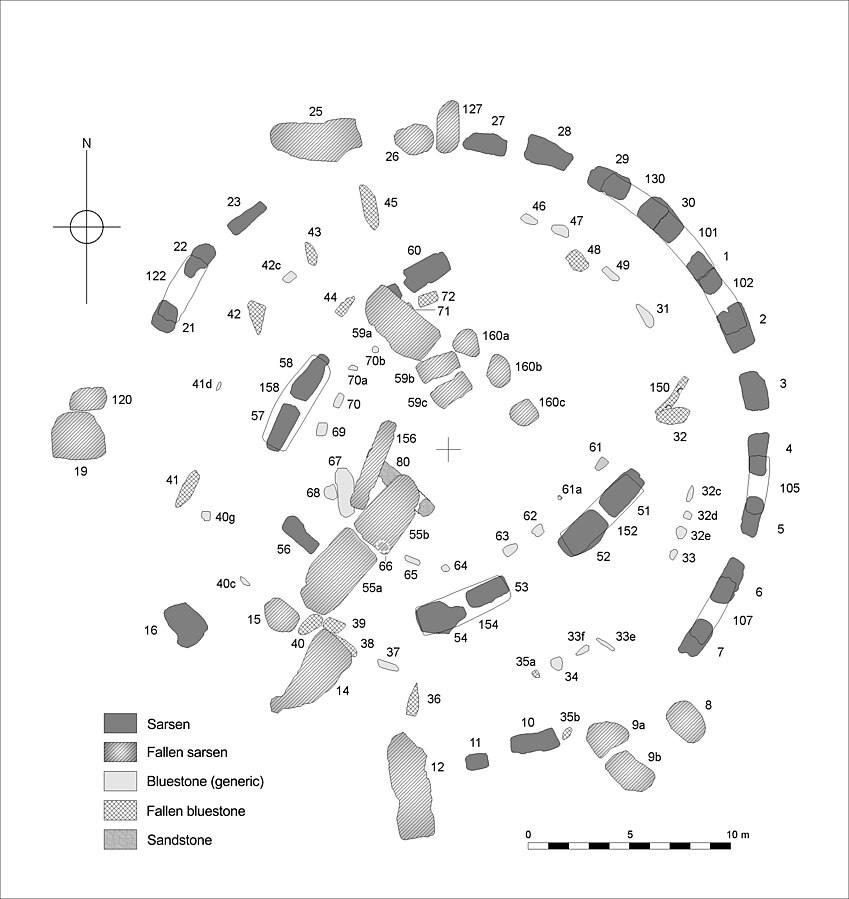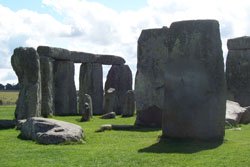Stonehenge
Stonehenge, probably the most famous prehistoric site in the world!!! It is of course the centre piece of this website's logo. The site can be found 8 miles north of the city of Salisbury Take the A345 and follow the signs. Buses run from Salisbury - take the Stonehenge Tour.
It is also one of the most famous Neolithic/Bronze Age sites in the world. Not the largest, nearby Avebury has that honour.
This being such a famous site there are naturally several organisations involved in its conservation.
The National Trust own the landscape around and English Heritage run the site, but the Crown actually owns Stonehenge.
From 1986 it became a World Heritage Site, along with the landscape around, the Avenue, the Cursus, Durrington Walls, Woodhenge, and what the World Heritage site describes accurately as "the densest concentration of burial mounds in Britain". This was an important and significant place. All are connected and part of the ancient Bronze/Neolithic ceremonial culture.
Needless to say it is also protected as a Scheduled Ancient Monument. This means that legally no one can change it.


Stonehenge.
Photograph © Copyright L Temple 2008
Mystic, massive circles of standing stones which line up with the rising sun on the midsummer solstice.
The site started as a circular bank and ditch with burial mounds around 3000 years ago. There are actually also signs of activity getting on for 8000 years ago!
The stones themselves were brought to the site, dressed, fashioned and erected in what is possibly a double ring. The large stones are Sarsen, a local sandstone block.
The blue stones were brought in later. They are much more mysterious and the debate still rages as to where they came from and how they got there. It would seem that their origin is in Pembrokeshire in Wales an awful long way away for transport in Stonehenge times. One theory is that that is what happened, stone age people did transport them. Others say that they are the result of glacial action and left when the glacier melted. An excellent overview of the debate plus a third option can be found on the Megalithic Portal.
Wikipedia have a very detailed and fascinating article tracing Stonehenge archeology and well worth reading.
Another Henge has been found on the prehistoric landscape at Durrington Walls.
Around 100 large stones like those at Stonehenge and Avebury were found by archaeologists using cutting age technology, The stones were under a large bank.
At the moment it looks as though those incredible prehistoric people pushed the stones over and built the bank over them. Obviously no longer needed!
The find seems to be putting the site in a new light.
The
landscape from Stonehenge to Avebury is full of prehistoric sites that
were at one time extremely important to the local people. Stonehenge was only part of this.
What those stones were for is also still open to conjecture – ritual or religious site the most likely scenario. With so much work it has to have been of major importance. Even allowing for its significance as a burial site.
To have lined up with the solstice suggests mathematical skill as well as construction skill, yet these people had no written language. Mind blowing!

The Wikipedia article mentioned above holds this intriguing plan of the stone structure that has survived.

Stonehenge Stone Plan
Author Anthony Johnson, CC BY 3.0 , via Wikimedia Commons
Stonehenge was built over centuries, 'bit' by 'bit', gradually improving and responding to the needs of the population and their leaders to what became a unified whole, not just the stones but the whole area of the Stonehenge location.
Archeological studies are revealing more about the what, but the how and why are still open to conjecture.

We marvel at the structure, but what about the people themselves who constructed it. That they were clever, innovative, artisans, mathematicians, scientists and construction experts is undoubted. They did not even have wheels, let alone the construction machinery we have today. It would have been designed by hand not a computer. What did they draw it on, there was no paper? They only had to draw their 'bit'.
They were farmers. Yes, farming stock. Neolithic people invented farming, Like any society they had their trades in the Neolithic or New Stone Age as we do today. It was these folk and a bit earlier hunter gatherers who are responsible for inventing those trades. It is them we must thank for everything we have today. Later generations have built on their skill as they built on that of their forebears.
Where did they come from, these more permanent folk in the landscape? Ice ages saw populations coming and going again as the ice came and went. Recent DNA tests of their bones from burials in the Stonehenge area show that they were originally from the Eastern Mediterranean. The generations slowly moved across to the area of Spain and Portugal before moving north across Europe and into Britain.
This timeline shows their progress over centuries from the hunter gathers of 8500BC to the Neolithic to build Stonehenge and the later history of this magnificent monument
.

Other pages that may be of interest

Return from Stonehenge to Home
Or you may perhaps wish to peruse the site some more. If so please use one of the navigation buttons on the left.


Incredible Stonehenge

Useful Information
Take the Stonehenge Tour. This takes passengers on a tour that visits not only Stonehenge but Old Sarum
as well.

Opening times for the monument vary with the season and can be found on the above link.

Accommodation
Plenty of hotels in Salisbury and Amesbury. All sizes all types. Stonehenge is a tourist hot spot!

Things change. Always check out the external links for the latest information.
These are just helpful suggestions only.
There is only one affiliate link, SBI.
Travel Wessex is a Guide.


This is a developing map. Some areas have better coverage.
To find the nearest Electric Vehicle Charging Point please click here.

Public Transport
If you do decide the leave the car at home and help the environment too, why not go National Express. They run coaches all over the country. Some pretty good fares too.
Just imagine - sit back and relax, no hassling with the traffic!!!
Do you know that you can book on your mobile phone and they will send the ticket as a text!!!!

National Rail Journey Planner.
For train journeys all over the United Kingdom connecting the places you want to go efficiently and quickly.

Traveline is a very useful resource for public transport throughout Wessex, even local buses. In fact all over the United Kingdom.



